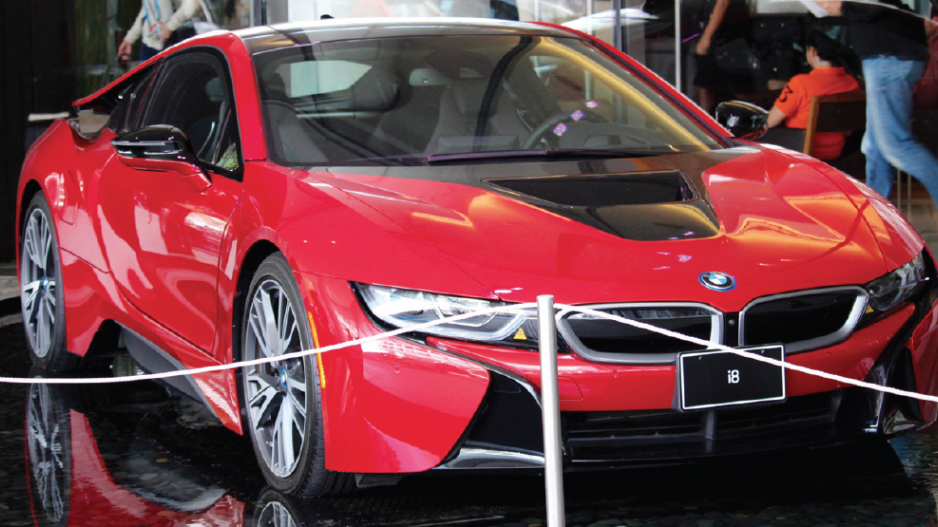Dirk Arnold envisions the future of mobility in two ways.
In one vein, BMW i’s vice-president of product management sees the ultimate ride-sharing app: a service that consolidates multi-modal transportation into one application that can take the average traveller through his or her entire daily commute.
“I think it will take another five to 10 years to solve all my daily mobility issues with just this,” said Arnold, motioning to his iPhone.
In another vein, Arnold sees charging technology replacing gas stations and parking lots as electric vehicles reach the level of sophistication and affordability that convinces drivers to park their gas guzzlers.
Last month, Arnold was in Vancouver to attend TED Talks and met with Business in Vancouver to discuss electric vehicle technology and promote his company’s two all-electric models: the i3 and the i8.
He foresees the day when mobility can be controlled from a smartphone, but the four-wheeled, emissions-free future was the core topic of conversation, and Arnold’s vision for electric vehicles is timely in B.C.
In February, the provincial government announced a $40 million fund to support clean-energy vehicles, $27 million of which will be allocated to the CEVforBC program, which ensures a $5,000 deduction off new electric vehicle purchases.
The remaining $13 million will be directed toward fast-charging, multi-unit residential and workplace charging, a vital investment in building the infrastructure needed for Arnold’s vision.
Charging technology has advanced significantly in the past decade, yet there are two looming developments in infrastructure that are dissuading motorists from jumping ship.
The first is the power and availability of plug-in battery chargers.
“Around 2020, the standard battery size will be roughly 100 kW [kilowatts], giving you a range of 300 kilometres-plus,” said Arnold. “With a high-power charger, you can fill up the battery in high speed, like 20 minutes from zero to 80%.”
BMW i is working on superchargers (350 kW and above), so charging time at plug-in stations will continue to decrease over the next five years.
In April, shopping centre giant Cadillac Fairview Corp. Ltd. announced a partnership with Canadian company Flo to deploy 45 networked charging stations at shopping locations across Canada.
Cadillac Fairview already has four charging stations in Vancouver at Pacific Centre, Granville Square, the HSBC building and Pender Place.
In B.C.’s Interior, Accelerate Kootenays, a multimillion-dollar coalition involving the regional districts of East Kootenay, Central Kootenay and Kootenay Boundary, along with corporate partners FortisBC and BC Hydro, has announced plans for a new set of electric charging stations along Highway 3.
According to BC Hydro, B.C. has approximately 1,000 public charging stations.
The second step for infrastructure development is the increase in what Arnold calls “inductive charging” or “charge plates” – charging platforms an electric vehicle can park on for a few hours to allow gradual recharging.
Charging infrastructure is key to reducing one of the main consumer concerns about buying electric: range anxiety, the fear that an electric vehicle’s charge won’t get the traveller to the desired destination.
Beyond all changes coming in the electric vehicle industry, Arnold still projects future mobility to include multiple types of transportation.
“We need a combination of all; sometimes you need a car rental or ride share, sometimes you need your own car,” said Arnold. “If you can provide an easy way to cover all transportation realms with one click, the customer would really love that because we are all trained to click.”
This future is part of the reason BMW i attended TED Talk.
At the conference, Arnold and his team announced they would be partnering with TED to present a new project called NextVisionaires.
“We don’t need the next cool product. What we are interested in is the overall concept of mobility, what it is and what can it look like in the different areas of the world.”
NextVisionaires will be a global competition that asks applicants to submit their ideas on the future of mobility. The best vision will be presented at the International Motor Show in Frankfurt, Germany, in September, and a panel of experts will determine a winner.
Arnold said NextVisionaires is aimed at finding “the step after the next step, to work with the community, the creative, the influential and the innovators on a joint platform and find out what could be the idea of mobility in 10 to 20 years.” •




